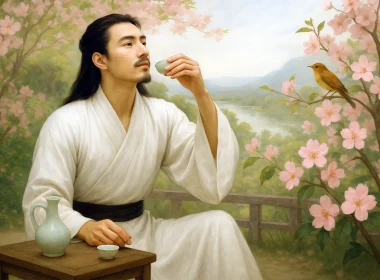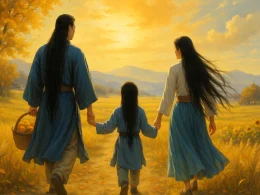The lonely swan won't drink nor eat,
But longs to join its flock to fleet.
Who will pity its shadow lonely,
Astray in the clouds,
it wails only.Out of sight,
still it seems in view;
Lost in grief,
its song's heard anew.
What do insensible birds know?
You hear only caws of the crow.
Original Poem:
「孤雁」
杜甫
孤雁不饮啄,飞鸣声念群。
谁怜一片影,相失万重云?
望尽似犹见,哀多如更闻。
野鸦无意绪,鸣噪自纷纷。
Interpretation:
This poem was composed around 766 AD, during Du Fu's stay in Fengjie, Chongqing. Due to the political turmoil in Sichuan, Du Fu left Chengdu with his family and drifted along the Yangtze River, eventually settling in Fengjie. In his later years, Du Fu lived in hardship, plagued by illness and the loss of old friends, leaving him in a difficult and lonely situation. This poem uses the image of a lone wild goose to express the deep emotions of wandering in a foreign land and longing for family and friends.
First Couplet: "孤雁不饮啄,飞鸣声念群。"
Gū yàn bù yǐn zhuó, fēi míng shēng niàn qún.
The lone wild goose neither drinks nor pecks; its cries as it flies are filled with longing for its flock.
The opening lines directly depict the state of the lone goose—its mournful cries vividly portray its lonely and helpless situation. The poet uses the goose's longing for its flock to express his own longing for family and friends while in exile.
Second Couplet: "谁怜一片影,相失万重云?"
Shuí lián yī piàn yǐng, xiāng shī wàn chóng yún?
Who will pity this solitary shadow, lost among layers of clouds?
This couplet uses the word "shadow" to emphasize the smallness and insignificance of the lone goose, portraying its迷茫无助 (lost and helpless) image in the vast sky. It also metaphorically reflects the poet's own漂泊无依 (wandering and helpless) and孤苦伶仃 (lonely and desolate) situation.
Third Couplet: "望尽似犹见,哀多如更闻。"
Wàng jìn sì yóu jiàn, āi duō rú gèng wén.
It gazes into the distance as if it can still see its companions; its mournful cries seem to grow louder, as if hearing their calls.
These two lines vividly express the goose's longing for its flock. The goose's思念 (longing) torments it, as if it can still faintly see its companions in the distance. Its continuous哀鸣 (mournful cries) seem to bring the calls of its lost flock closer. This illusion of seeing but not reaching, hearing but not connecting, deeply conveys the goose's pain and persistence, as well as the poet's own难以割舍 (hard to let go) feelings for his loved ones.
Fourth Couplet: "野鸦无意绪,鸣噪自纷纷。"
Yě yā wú yì xù, míng zào zì fēn fēn.
The wild crows, devoid of emotion, caw noisily and chaotically.
The poet uses the "wild crows" as a contrast to the lone goose, using their noise to highlight the goose's solitude and sorrow. This also reflects the poet's感慨 (reflection) on the冷漠 (indifference) of the world and the lack of empathy among people.
Overall Appreciation
This poem uses the image of a lone wild goose to express the sorrow of wandering far from home and longing for family and friends. The poet personifies the goose, depicting its mournful cries, its search for its flock, and its persistent longing, creating a vivid image of a goose filled with emotion and unwavering determination. Through this, the poet expresses his own feelings of displacement, the loss of loved ones, and the frustration of his career. The line "its mournful cries seem to grow louder" shows the poet's extreme sorrow, even to the point of幻觉交错 (hallucinatory confusion), which is deeply moving.
Writing Characteristics
- Using Objects to Express Emotion, Profound Meaning: While the poem ostensibly describes a lone goose, it is actually a reflection of the poet's own emotions. The lone goose is the poet, and the goose's longing for its flock represents the poet's longing for his loved ones.
- Contrast Technique, Highlighting Sorrow: The mournful cries of the lone goose contrast sharply with the noisy indifference of the wild crows, further emphasizing the poet's inner loneliness and sorrow.
- Subtle Emotions, Layered Progression: The poem progresses from "longing for the flock" to "lost among clouds," then to "gazing into the distance" and "mournful cries," deepening the goose's pain and the poet's longing for his loved ones. The emotional起伏 (fluctuations) are gripping and poignant.
Insights
This poem uses the lone wild goose as a symbol to depict the human pursuit of familial and fraternal bonds amidst suffering. Through the goose, the poet expresses his own sorrow and pain of displacement and loss. It reminds us that despite the separations and hardships in life, emotional attachment and perseverance remain vital forces that sustain the human spirit. The lone goose's refusal to give up its search makes its emotions all the more sincere and steadfast.
Poem translator:
Xu Yuan-chong (许渊冲)
About the poet

Du Fu (杜甫), 712 - 770 AD, was a great poet of the Tang Dynasty, known as the "Sage of Poetry". Born into a declining bureaucratic family, Du Fu had a rough life, and his turbulent and dislocated life made him keenly aware of the plight of the masses. Therefore, his poems were always closely related to the current affairs, reflecting the social life of that era in a more comprehensive way, with profound thoughts and a broad realm. In his poetic art, he was able to combine many styles, forming a unique style of "profound and thick", and becoming a great realist poet in the history of China.












